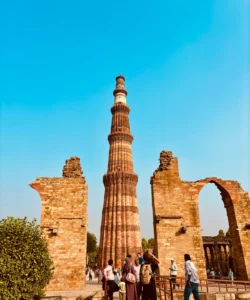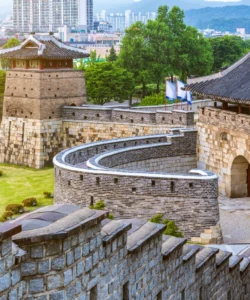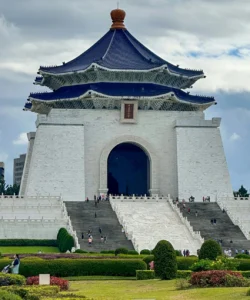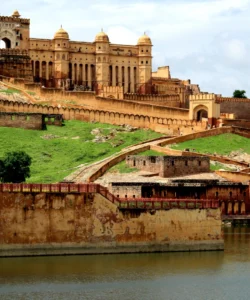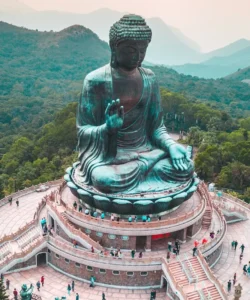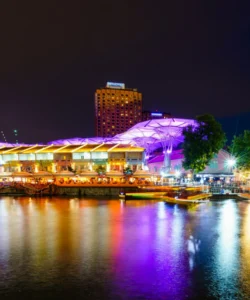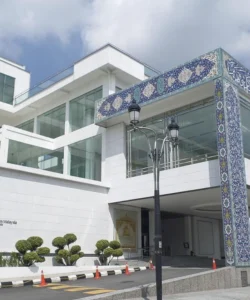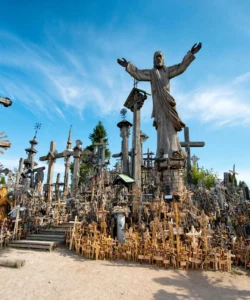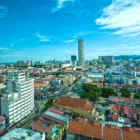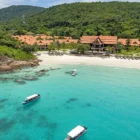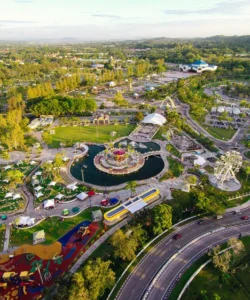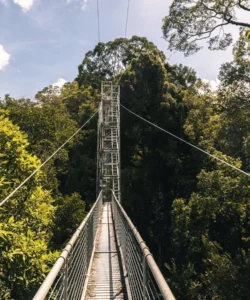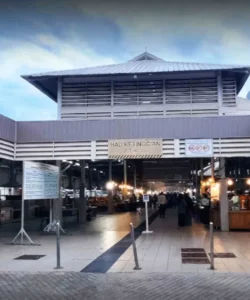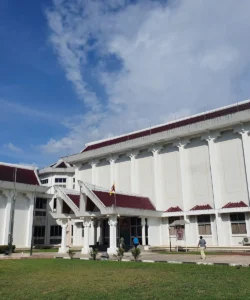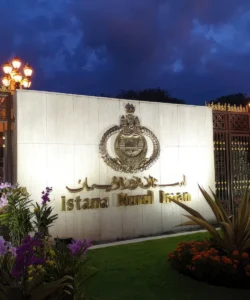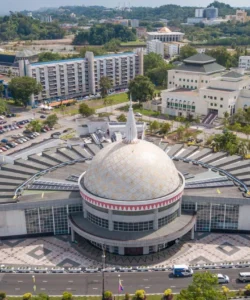The Royal Regalia Museum is a prominent landmark in the heart of Bandar Seri Begawan, Brunei Darussalam, serving as a powerful testament to the Brunei Sultanate’s opulent history, cherished traditions, and immense wealth. It is dedicated to showcasing the royal paraphernalia and ceremonial items of the Sultan and other members of the royal family.
Name: Royal Regalia Museum (Malay: Muzium Alat Kebesaran Diraja)
Address: Jalan Sultan Omar Ali Saifuddien, Bandar Seri Begawan BS8610, Brunei Darussalam. It is centrally located in the capital city, making it a key stop on most city tours.
How to Get There:
The Royal Regalia Museum is very accessible in Bandar Seri Begawan.
- By Air: The closest airport is Brunei International Airport (BWN). From the airport, it’s a short 10-15 minute taxi or ride-sharing (Dart) trip to the museum.
- By Taxi/Ride-Sharing (Dart): Taxis and Brunei’s local ride-sharing service, “Dart,” are readily available throughout Bandar Seri Begawan for direct transfers.
- By Bus: Numerous public bus routes pass near the Royal Regalia Museum, with bus stops typically within a short walking distance.
- By Foot: If staying in the central Bandar Seri Begawan area, the museum is conveniently located within walking distance of many hotels, the Sultan Omar Ali Saifuddien Mosque, and the Kampong Ayer water village.
- Organized Tours: Most city tours in Brunei include a visit to the Royal Regalia Museum as a highlight.
- Entrance Fee: Admission is typically free for Brunei residents and a nominal fee for non-residents. Visitors are generally required to remove their shoes before entering and bags may need to be stored in lockers. Photography is usually allowed in the main lobby but restricted inside the exhibition galleries. Modest dress is advised.
Landscape and Architecture:
The Royal Regalia Museum’s architecture is a distinctive blend of modern design and traditional Malay Islamic Monarchy (Melayu Islam Beraja – MIB) philosophy, reflecting Brunei’s cultural identity.
- Former Churchill Memorial Building: The museum is housed in a building originally constructed in 1965 as the Churchill Memorial Building. It underwent a significant renovation and expansion in 1992, combining its original structure with new elements.
- Unique Crescent Shape and Dome: The building maintains its distinctive crescent shape from its original design, which is complemented by a later-added dome-capped section and a semi-circular atrium. The main dome, a prominent feature, is adorned with golden flower mosaics (“bunga putar” motifs) that mirror patterns found in the Sultan’s royal attire.
- Spire Resembling an Umbrella: The dome is topped with a white, 13.5-meter (44 ft) tall spire intentionally shaped like an umbrella, a salient symbol of protection and vigilance in Brunei’s royal regalia.
- Grand Interior: The interior of the museum features a grand marble hall, with most of the exhibition spaces covered in plush carpets and white marble flooring (Black Assoluto granite in the main gallery). The design is spacious and well-lit.
- “Kalasak” Door Designs: The main entrance doors are modeled on the “kalasak” (a type of traditional long blade/shield design), symbolizing strength and unity.
- Integration of Traditional Motifs: Throughout the museum’s design, traditional Brunei Malay motifs are intricately woven in, from the “pucuk rebung” (bamboo shoots) pattern in carpets to the royal heraldry (like the Ambal, Payung Ubur-Ubur, Tunggul Kawan, and Dadap) decorating the internal ribs of the dome.
What Makes It Famous:
- Extensive Royal Regalia Collection: The museum is most famous for its vast and opulent collection of royal regalia, ceremonial weaponry, jewel-encrusted crowns, traditional costumes, and gilded chariots used during royal ceremonies, particularly the Sultan’s coronation in 1968 and his Silver Jubilee celebrations in 1992.
- Commemorates the Sultan’s Reign: It was officially opened in 1992 to coincide with the Silver Jubilee of Sultan Hassanal Bolkiah’s reign, making it a direct tribute to the current monarch and a showcase of his life, education, and rule.
- Magnificent Royal Chariot: A life-sized, incredibly ornate golden royal chariot (usongan diraja), used by the Sultan during parades, is a central and awe-inspiring display in the main gallery.
- Gifts from Foreign Dignitaries: A significant section of the museum displays a vast array of gifts presented to the Sultan by foreign heads of state, dignitaries, and Bruneian citizens, ranging from humble items to elaborate works of art crafted from gold, silver, jade, and crystal, showcasing Brunei’s diplomatic relations and international standing.
- “Crash Course” in Brunei’s History and Monarchy: For visitors, it offers an invaluable and immersive insight into the history, traditions, and enduring legacy of the Brunei monarchy, from ancient times to modern independence.
- Symbol of National Pride: The museum embodies Brunei’s strong sense of national pride, its commitment to preserving its heritage, and the enduring power and prestige of its Malay Islamic Monarchy (MIB) philosophy.
Differences from Some Other Wonders:
- Specialized Focus on Royal Regalia: Unlike general museums (like the National Museum of Singapore, which covers broad national history, or the Islamic Arts Museum Malaysia, which covers broader Islamic art), the Royal Regalia Museum has a highly specific and unique focus on Brunei’s royal regalia, monarchy, and ceremonial history. Its entire collection revolves around the Sultan and the royal family’s personal and ceremonial items.
- Direct Tribute to a Living Monarch: While many historical sites are linked to past monarchs, this museum is explicitly a tribute to the current Sultan, showcasing his personal history, reign, and the celebration of his jubilees, making it more of a “living” royal chronicle.
- Display of Diplomatic Gifts: The extensive collection of gifts from world leaders is a unique feature that highlights Brunei’s international relations and the personal connections of its Sultan, a type of exhibit not typically found in other national museums to this extent.
- Architectural Blend of Old and New: Its design, which carefully maintains the unique C-shaped structure of its original 1960s building while seamlessly integrating modern additions and a prominent dome, showcases a specific form of adaptive reuse that symbolizes both continuity and innovation.
- Emphasis on Opulence and Wealth: The sheer lavishness of the displayed items (gold, jewels, intricate craftsmanship) directly reflects Brunei’s immense national wealth, derived from its oil and gas resources, and its dedication to the monarchy, giving it a distinct air of opulence compared to many other museums.
- No Photography in Galleries: The strict “no photography” policy within the exhibition galleries (common in some museums but not all) distinguishes the visitor experience, emphasizing respectful viewing and contemplation of the artifacts rather than casual photo-taking.
Royal Regalia Museum Photos:




















